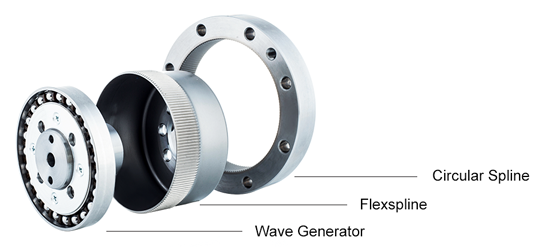Harmonic Gearbox Components
The harmonic transmission consists of three basic parts, i.e. wave generator, Flexspline and Circular spline.
Wave generator (VG): the inner part consists of an elliptical cam on which a special flexible ball bearing is located. In most applications, the VG is the input element of the conversion.
Flexspline (FS): is a flexible gear which is formed by a semi-closed thin-walled cylinder, with an outer tooth at the open edge. In most applications, the FS is an output element.
Circular Spline (CS)
: Rigid gear, there is a tooth on the inside, generally has 2 more teeth than Flexspline. In most applications, the CS is fixedly anchored and is not a moving element of the gearbox.
The principle of harmonic gearbox
When the harmonic gear is used for speed reduction, the Wave Generator is active, the Circular spline is fixed and the Flexspline is output.
In the assembled state, the elliptical cam VG is inserted into the open part of the FS. The flexspline deforms into an oval shape due to elasticity, then the FS teeth at the long axis point are thoroughly inserted into the rigid spline to achieve a complete shot condition. At the same time, the two gear wheels do not touch at all at the short axis point, in other words, they are in the disconnected position. In the process from engagement to disengagement, the gear wheel with the traction wave is in the engagement or disengagement state.
When the wave generator is constantly rotating, the flexspline is constantly deforming, the two gear wheels change their own working state – retracting, engaging, extending to disengaging, so there is a so-called alternating motion, finally the transfer of motion from the wave generator to the flexspline is achieved.
Characteristics of harmonic gearbox
High precision: multiple teeth simultaneously occupy 180° symmetrically in two positions, therefore the gear tooth gap error and accumulated tooth gap error uniformly affect the rotation accuracy, and therefore extremely high position and rotation accuracy can be achieved.
Large gear ratio: the single-stage gear ratio of the harmonic reducer can reach i=30 to 500, moreover, the structure is very simple, and the three basic parts on the same axis can easily achieve a high reduction ratio.
High load capacity: in harmonic reducer, the tooth engagement belongs to the surface contact, moreover, it can engage relatively more teeth at the same time, therefore the unit surface bears a small load and the load capacity is higher than other forms of gears.
Small size and light weight: Compared with the conventional transmission equipment, the harmonic reducer can greatly reduce the size and weight, thus achieving miniaturization and light weight in production.
High transmission efficiency and long service life.
Smooth transmission, no vibration and little noise.
A new look on harmonic gearing.
Innovation, technical advantages
Traditionally, the design of rigid gear sold in the market is based on conjugate network theory (Willis theorem).
However, our LD researchers have found that gear meshing with a deformation wave is more complex. The harmonic gearing can be more accurately described using the theory of geometric curve mapping. By incorporating this theory into the design, this patented technology has significantly improved the engagement of the gearing with the pulling waves, setting the product apart from the competition. The design can be further extended to fixed high ratio reducers for better accuracy and control.
Tooth profile P-type
The unique P-type profile has significant advantages over the typical profile:
- The lower profile reduces bending stress at the base, improving torque capacity.
- The wide tooth base and efficient profile transition reduces stress concentration in the core.
- The lower profile reduces displacement and tension in the Flexspline, resulting in a longer Flexspline life.
- More than 20%-30% of the teeth compared to other competitors in the shot contact reduces the surface contact pressure.




